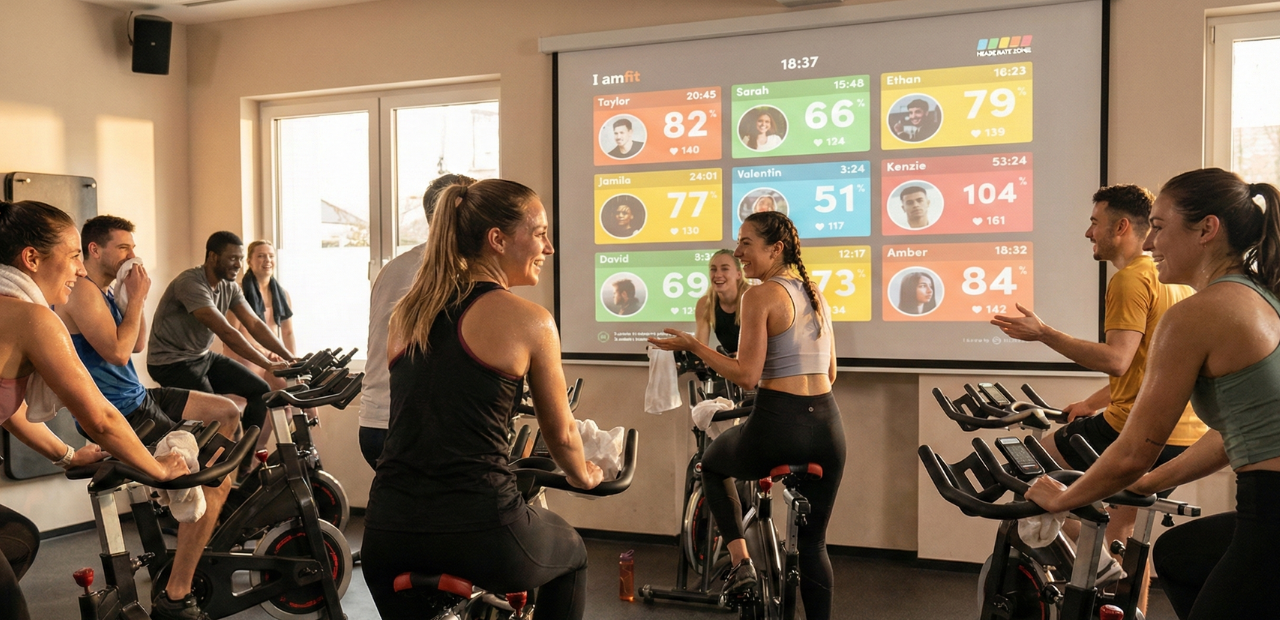These days, your gym’s app isn’t just an accessory—it’s often your first impression.
When someone joins your club, they don’t just look at your facility. They check the app. They test the booking system. They want to know: how easy is it to engage with your brand on their phone?
A well-designed, well-branded app makes that experience seamless. But many fitness businesses still settle for something generic.
A templated layout, mismatched branding, confusing navigation. The result? Low adoption. Minimal loyalty. Lost revenue.
Done right, a branded mobile app isn’t just a digital touchpoint—it’s a reflection of your gym’s identity. It shows members you’re professional, consistent, and invested in their experience.
In this blog, we’re digging into how fitness businesses are using mobile app branding to boost retention, improve engagement, and grow stronger brands—from the app icon to onboarding, and everything in between.
This isn’t about fancy features. It’s about giving your members something that feels like it was built for them—because it was built by you.
Mobile app branding: why this matters now?

Data is clear: +63% of people navigates on their phone vs desktop. What can we learn from this? That your members already expect to manage everything from their phone. If you’re not offering a mobile experience, someone else is.
For context, Virtuagym apps powered over 5.2 million bookings last year. That’s more than just convenience, it’s daily engagement.
And it’s not limited to booking:
- 46% of users rely on the app for strength workouts. That’s 46% of users logging workouts weekly—no trainer follow-up needed.
- 35% use it for cardio tracking
Those numbers show what’s possible when your app becomes a habit—not an afterthought.
But what if you’re a smaller gym or PT studio? It’s not about volume. It’s about making access to your services easy, reliable, and always on-brand.
Your app should feel like your gym

Open your app. If your members see a different brand—or worse, something that looks like it came off a template site in 2012—you’ve lost them.
The app icon, app name, layout, colors, tone—these aren’t just decorations. They’re signals. If they don’t match your own brand, you’re blending into the background.
Here’s the test: Would your app still feel like you if you removed your logo? If not, you’ve got a problem.
Your branded app should carry the same weight as your front desk or your website. It should build brand loyalty with every tap, not erode it with every clunky screen.
And yet—most gyms still launch apps that look nothing like their business.
One of our clients rebuilt their app icon to match their signage and adjusted their color palette to fit their in-gym branding. Result? +30% app downloads in just weeks. Because members finally recognized it.
Want to dive deeper into gym branding? Check out our complete guide to building a standout fitness brand.
Booking shouldn’t require a tutorial

Let’s be blunt: if members can’t book in under 10 seconds, they probably won’t book at all.
The fastest way to kill engagement? A booking system that’s confusing, glitchy, or buried under five tabs.
Think of your app as a conversion tool, not a menu. A good mobile app doesn’t just manage bookings—it drives them.
For example, Virtuagym clients prove it:
- 3.5 million bookings from gyms
- 1.1 million from studios
- Over 500,000 from solo trainers
High engagement like this doesn’t come from a clunky experience: it comes from intuitive design. When booking and navigation feel effortless, members keep coming back
Even in a one-location studio, the logic applies. Every tap saved is a friction point removed. That’s how you drive repeat visits—and revenue.
Don’t bury your services behind login loops. Put the call-to-action where it belongs: front and center.
One app, not five platforms

If you’re using one tool for bookings, another for meal tracking, another for workouts, and WhatsApp for follow-ups… stop. That’s not scalable. And it’s definitely not professional.
Mobile app branding strategies start with consolidation. Bring everything into one branded app. One login. One voice. One user experience.
Lifestyle Change did exactly that. Before, they were juggling:
- Booking app
- Food log
- Workout PDFs
- Spreadsheets
Their clients felt like they were doing more admin than training.
Once they launched their branded app with Virtuagym, it all changed. The entire user base had one place to book, train, check-in, and chat with their coach.
Check-ins doubled. No-shows dropped. And for the first time, their digital brand finally felt like their real business.
You don’t need an enterprise budget. You need clarity. Create one ecosystem, branded in your style, that makes your service as smooth online as it is in person.
Push notifications that feel human

Nobody wants another robotic push that says “Update available.” Your app isn’t a software product—it’s an extension of your coaching.
So talk like it. Mobile app branding isn’t just visual—it’s tonal. Every notification is a micro-brand moment.
Virtuagym’s tools let you automate behavior-based nudges. Skipped a session? Ping. Completed a challenge? Congratulate them. Haven’t checked in for 7 days? Gently re-engage.
Push is powerful—but only if it sounds like it’s coming from you, not a system.
Community is the retention engine

Programs get people through the door. Community keeps them there.
Inside your app, you can create group chats, run challenges, and show leaderboards. These features turn solo efforts into shared ones.
We’ve seen clients run in-app challenges with 80%+ completion—because members feel seen, supported, and part of something.
Launching isn’t the finish line

You don’t need to be a tech expert to launch an app. But you do need a rollout plan.
Start with your brand. Define your voice, your visuals, and your goals.
Then map the flow. What’s the first thing new users should see? What action should they take in week one?
Launch in phases. Staff first. Then your most engaged clients. Then everyone.
Build your idea of a branded fitness app: a step-by-step guide

If you’re reading this and thinking, “Sounds great—but where do I even start?” you’re not alone.
Mobile app branding may seem like a big step, but with the right process, it’s completely achievable for any fitness business.
Extra tip: if you want to go further with the app branding we have these blogs for you:
Top Gym Apps of 2025 for Gym Owners Who Want to Stay Ahead
Best Fitness Apps Tested by Fitness Trainers in 2025
1. Start with your brand identity, not your logo
The journey starts with understanding your brand. What is your brand identity? What makes your gym or studio stand out from competitors? Your app should be an extension of that—from the app icon and app name to the loading screen and color scheme.
2. Collaborate with your design team
Once you have your core elements mapped out, you’ll work with a design team (or use your own if you have one) to bring that identity into the app interface.
This includes visual brand design, tone of voice, and the brand’s icon that members will recognize every time they check their phone.
3. Prioritize essential functionality
Next is functionality. What do your users need? Booking? Nutrition tracking? Workout plans? Messaging? Think in terms of features that solve actual problems—not vanity add-ons.
This is exactly how Lifestyle Change approached their project. They started with their mission—to offer continuous coaching and support outside the studio—and turned that into a digital experience. Their branding strategy was simple: make their app feel like their gym.
“We have big ambitions. We don’t just want to make an impact; we want to grow Lifestyle Change into a nationally recognized brand.”, says Leviene.
They created an app with consistent visuals, a logical flow, and clear onboarding. They uploaded branded screenshots to the Apple App Store and Google Play Store, created optimized landing pages, and used social media and email to drive downloads.
When asked about the app, this is what one of the owners says:
“It’s so simple,” says Gerda. “It lowers the threshold and ensures everyone can easily join.”
The result? Their user base now engages daily. The app didn’t just mirror their brand image—it became part of their brand story.
👉 Want to see how Virtuagym would work in your own center?
Try the free demo. If your current system is costing you members, you’ll know in 30 minutes
Add features your clients will enjoy

Mobile app branding isn’t just about how your app looks—it’s about how it works for your users.
A successful mobile app branding strategy requires delivering features that feel like an extension of your fitness business, not a generic software bundle. To impress your target audience, you need a branded app that balances aesthetics with usability, offering functions people actually want to use every day.
Start by focusing on the core elements your users expect:
1. Smart booking and scheduling
No one wants to play phone tag or scroll through outdated class calendars. A successful app should let users book classes or personal training sessions in seconds. Ideally, it syncs with their phone’s calendar and sends reminders through smart, personalized push notifications.
2. Personalization through customizable plans
Whether it’s strength training or weight loss, users want plans that reflect their goals. Build in the ability for trainers to assign, adjust, and monitor workouts and habit trackers. Bonus: Include templates that fit different fitness levels or time commitments.
3. Nutrition and lifestyle tracking
In-app food logs and wellness prompts keep users engaged with your brand’s image even outside the gym. Link these tools with coaching programs to deepen the value of your service.
4. Engagement through community
Community features—like group chats, leaderboards, and in-app challenges—can dramatically increase retention. Users feel like they’re part of something bigger. Tie it into your brand by customizing the visuals and language to reflect your tone.
5. Recognition and reward systems
Include gamification or loyalty features: milestone badges, progress dashboards, points systems, or check-in streaks. These provide a tangible sense of achievement and keep your app sticky.
6. Seamless e-commerce integration
Your app can do more than schedule and coach. With smart e commerce features, it becomes a revenue generator. Sell merchandise, offer digital training programs, or let users upgrade to premium memberships—all from one place.
7. Consistent brand presence across all touchpoints
Make sure everything—from the app icon and app name to your loading screen and screenshots—tells a unified story. This is where app branding makes the leap from visual asset to growth tool.
Most apps fail because they stop at design. But a strong brand strategy means aligning every click and screen with your identity. When that happens, your branding guidelines don’t just sit in a PDF—they come to life on your members’ phones.
Want your branded app to stand out in the Apple App Store or Google Play Store? Optimize your listings with compelling keywords, clean screenshots, and an app description that communicates your unique selling proposition clearly to your audience.
Pro tip: Look at your top-performing social posts or email subject lines. These are great clues for how to write your app store copy.
And don’t forget about landing pages. These are essential to drive traffic from email, social media, or paid campaigns. A clean, mobile-friendly page that reflects your brand design and offers a direct download link can significantly boost your install rate.
The real success comes from doing the small things right—consistently, and in your own brand’s voice.
If your branding guidelines are inconsistent or if your app name doesn’t match your gym’s identity, you lose recognition in the app store search. And when the app icon looks too similar to competitors or lacks visual clarity, users won’t tap.
👉 Want to see how Virtuagym would work in your own center?
Try the free demo and find out in 30 minutes if your current system is reducing your member retention. No strings attached.
How to measure success

This isn’t just a digital business card. A well-executed branded app has a crucial role in increasing revenue, lowering churn, and expanding your customer base.
It helps your company create stronger impressions, gain visibility in the Google Play Store (Android) and Apple App Store (iOS), and stay top of mind.
If you add even a modest e commerce component—like paid programs, drop-in sessions, or upsells—you’ve just opened a new sales channel. All of it powered by consistent, recognizable app branding.
Your members already expect seamless experiences from other apps. If you want to be seen as a modern fitness business, you have to match that level of brand building.
The good news? You don’t have to figure it all out alone.
Virtuagym helps you identify your unique selling proposition, guide you through branding strategy, assist with upload processes, and optimize your presence on android, ios, and every relevant social platform.
We’ll help you speak to your audience clearly and confidently—from app interface to promotional assets. Whether you’re just starting to build your app or need to revamp your current one, the process becomes easier with expert support.
3 myths about branded apps (that are costing you clients)
Myth 1: “If it looks good, it’ll work.”
Reality: Design is important—but it’s not enough. Most fitness apps fail because they aren’t built around the member journey. A beautiful interface without intuitive booking, reminders, or retention tools is just window dressing. Your app needs to solve real problems, not just look the part.
Myth 2: “A white-label app is just as good.”
Reality: Slapping your logo on a prebuilt app won’t cut it. If your app icon looks like five other studios in the App Store, you’re not building a brand—you’re blending in. Successful mobile app branding is about consistency: your voice, your tone, your flow—not just your name.
Myth 3: “Apps are only for big gyms with big budgets.”
Reality: Not anymore. Boutique studios, PTs, and even solo coaches are using branded apps to simplify bookings, offer coaching, and build communities. The real ROI isn’t about scale—it’s about stickiness. If your clients engage more and stay longer, you’ve already won.
Ready to build loyalty that lasts?
A branded mobile app isn’t just a feature—it’s a strategy.
It gives your business a daily presence, a unified experience, and a powerful way to keep members coming back.
🎯 Book a free demo with Virtuagym and see what your own app could look like.




